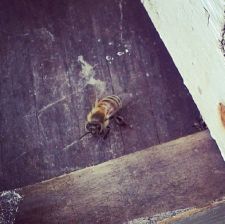Back to Beekeeping
Posted by Bob Barcus on May 21st, 2013
Last week, an old family friend was somewhat frantic after a swarm of bees had come to rest in a lilac bush in her front yard. Naturally, I was called to the scene to take care of her problem, seeing as how I have been keeping bees since I was in fifth grade.
For the last three or four years, I’ve been without bees. At one time, I had three colonies in my back yard. But like most beekeepers in the United States, I had a problem – my bees kept dying.
Like most beekeepers, I didn’t know what was killing my bees. Colony collapse disorder (CCD) is a phenomenon that many scientists, experts and studies have now linked to a group of pesticides known as neonicotinoids. While some have tried to blame CCD on mites and cell phones, I’m fairly confident that the neonicotinoids are the real culprit.
Produced by Bayer CropScience, neonicotinoids can and will kill bees. In 2008, Germany banned the use of clothianidin, a type of neonictonoid found in a pesticide known as Poncho. An error by a seed company allowed the chemical to become airborne, resulting in the deaths of millions of honeybees along the Rhine River. 99% of the dead bees tested positive for lethal levels of clothianidin. Even according to the EPA, clothianidin is highly toxic to bees.
Even though these neonicotinoids are widely used in the United States and many studies have linked these pesticides to CCD, Bayer refuses to admit that its products are the cause of the problem. Basically, they’re saying that a pesticide that is widely used on a number of crops and has been proven to be highly toxic to honeybees simply could not be suspect. Yeah, right. Other countries have been banning neonicotinoids and honeybee populations have been rebounding.
In 2009, Italy joined France and Germany in banning neonicotinoids and the results were not startling – honeybee populations bounced back. With the ban in place, Italy suffered only one incident of CCD (and that was attributed to someone planting neonicotinoid-coated seed from a previous year).
This last winter, American honeybee colonies were decimated. Over 30% of the managed colonies in the United States were killed. At this rate, we’re not going to have any bees left. That’s why I was so excited to capture a swarm. It makes me feel like I’m doing my part of save the bees. While I could very easily lose this colony the next time someone decides to spray a neonicotinoid on their field, I’m going to do my best to protect these amazing little creatures.

